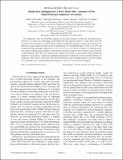Small mass plunging into a Kerr black hole: Anatomy of the inspiral-merger-ringdown waveforms
Author(s)
Taracchini, Andrea; Buonanno, Alessandra; Khanna, Gaurav; Hughes, Scott A
DownloadHughes_Small mass.pdf (1.880Mb)
PUBLISHER_POLICY
Publisher Policy
Article is made available in accordance with the publisher's policy and may be subject to US copyright law. Please refer to the publisher's site for terms of use.
Terms of use
Metadata
Show full item recordAbstract
We numerically solve the Teukolsky equation in the time domain to obtain the gravitational-wave emission of a small mass inspiraling and plunging into the equatorial plane of a Kerr black hole. We account for the dissipation of orbital energy using the Teukolsky frequency-domain gravitational-wave fluxes for circular, equatorial orbits, down to the light-ring. We consider Kerr spins −0.99 ≤ q ≤ 0.99, and compute the inspiral-merger-ringdown (2,2), (2,1), (3,3), (3,2), (4,4), and (5,5) modes. We study the large-spin regime, and find a great simplicity in the merger waveforms, thanks to the extremely circular character of the plunging orbits. We also quantitatively examine the mixing of quasinormal modes during the ringdown, which induces complicated amplitude and frequency modulations in the waveforms. Finally, we explain how the study of small mass-ratio black-hole binaries helps extending effective-one-body models for comparable-mass, spinning black-hole binaries to any mass ratio and spin magnitude.
Date issued
2014-10Department
Massachusetts Institute of Technology. Department of Physics; MIT Kavli Institute for Astrophysics and Space ResearchJournal
Physical Review D
Publisher
American Physical Society
Citation
Taracchini, Andrea, Alessandra Buonanno, Gaurav Khanna, and Scott A. Hughes. “Small Mass Plunging into a Kerr Black Hole: Anatomy of the Inspiral-Merger-Ringdown Waveforms.” Phys. Rev. D 90, no. 8 (October 2014). © 2014 American Physical Society
Version: Final published version
ISSN
1550-7998
1550-2368